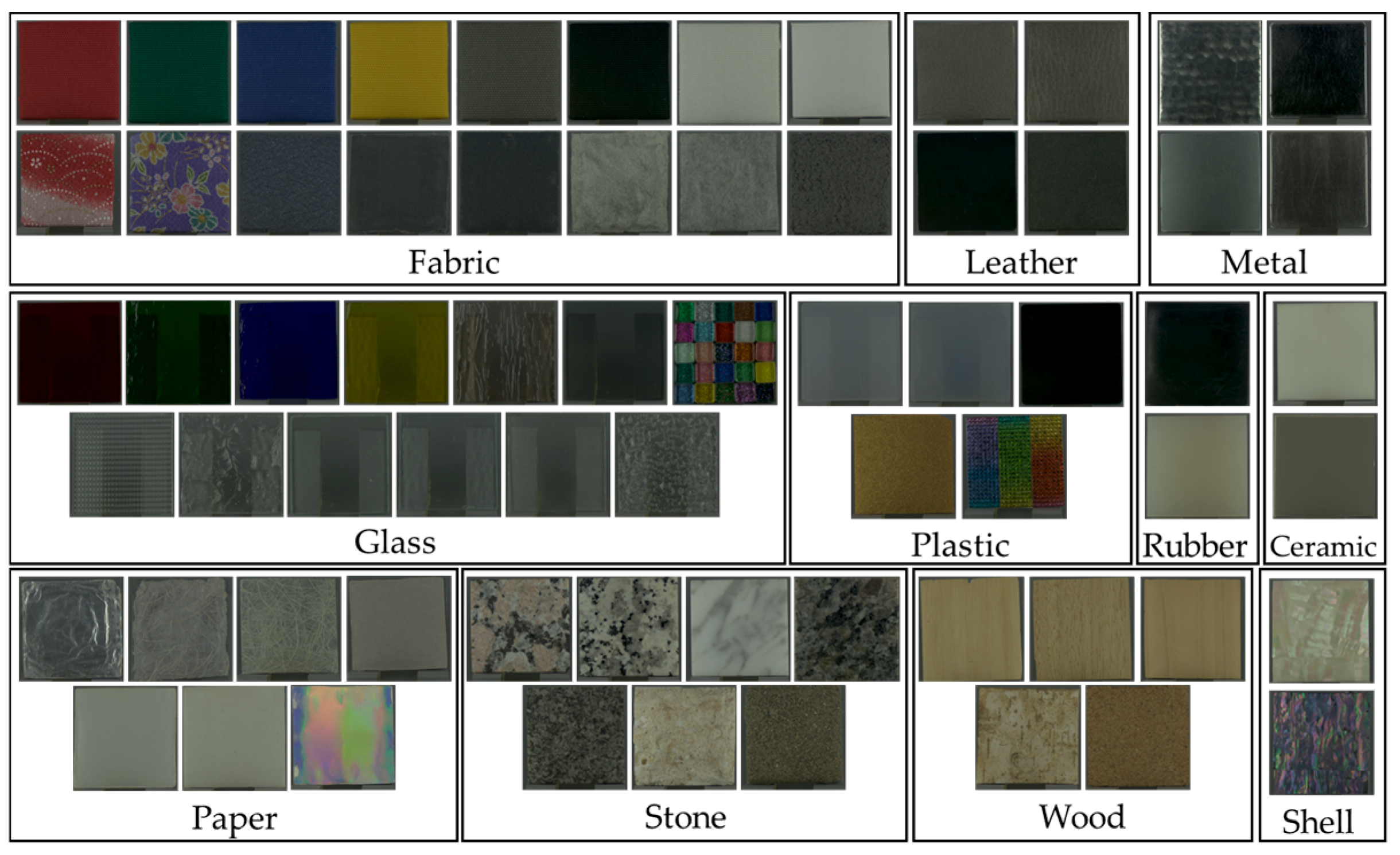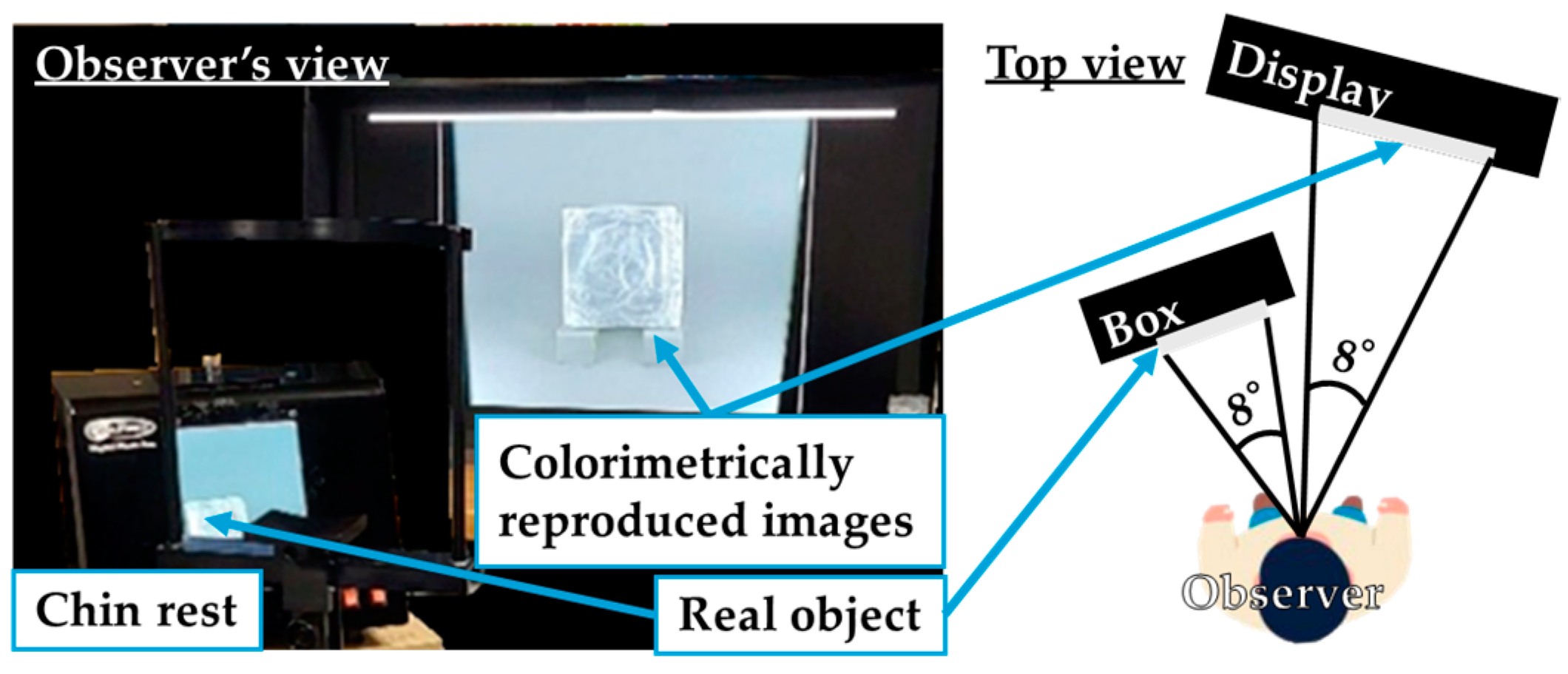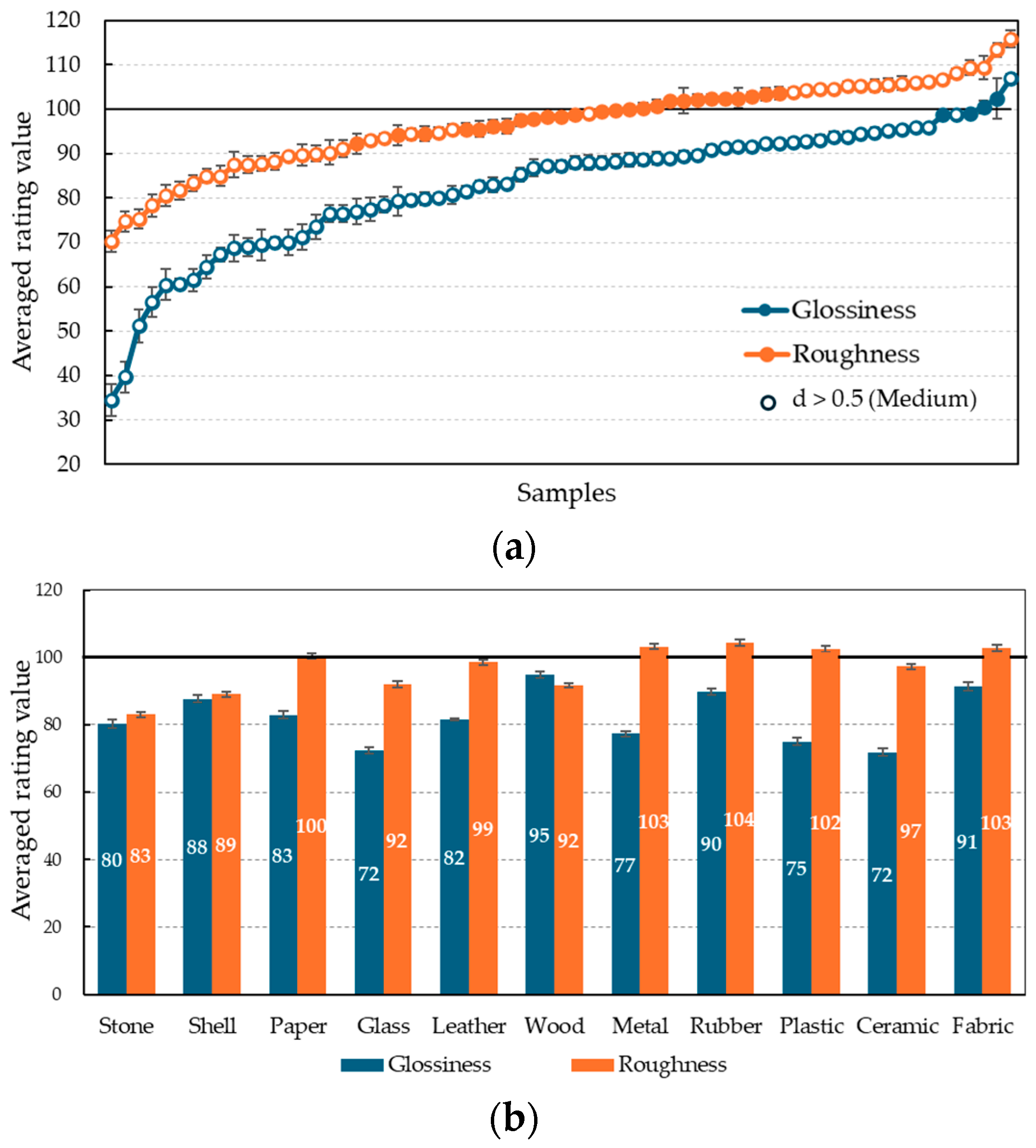Analysis of Physical Features Affecting Glossiness and Roughness Alteration in Image Reproduction and Image Features for Their Recovery
Abstract
1. Introduction
2. Experiment A
2.1. Experimental Stimuli
- Real stimulus
- Image stimulus
2.2. Experimental Procedure
2.3. Result of Perceptual Alteration
- Glossiness
- Roughness
- General discussion
2.4. Analysis of Physical Features of Objects That Affect Perceptual Alteration
2.4.1. Surface Roughness Measurement of a Real Object
2.4.2. Physical Features That Significantly Influence Glossiness and Roughness
- Glossiness
- Roughness
3. Experiment B
3.1. Experimental Stimulus
- Image stimulus for glossiness
- Image stimulus for roughness
3.2. Experimental Procedure
3.3. Result
- Glossiness
- Roughness
4. Conclusions
Author Contributions
Funding
Institutional Review Board Statement
Informed Consent Statement
Data Availability Statement
Conflicts of Interest
References
- CIE 175:2006; A Framework for the Measurement of Visual Appearance. International Commission on Illumination, CIE: Vienna, Austria, 2006; p. 92.
- CIE x032:2007; Proceedings of the CIE Expert Symposium on Visual Appearance. International Commission on Illumination, CIE: Vienna, Austria, 2006.
- Spence, C. Shitsukan—The multisensory perception of quality. Multisens. Res. 2020, 33, 737–775. [Google Scholar] [CrossRef] [PubMed]
- Chadwick, A.C.; Kentridge, R.W. The perception of gloss: A review. Vis. Res. 2015, 109, 221–235. [Google Scholar] [CrossRef] [PubMed]
- Beuckels, S.; Audenaert, J.; Leloup, F.B. Optical characterization of the psychophysical surface gloss space in the presence of surface haze. Opt. Contin. 2023, 2, 535–536. [Google Scholar] [CrossRef]
- Chen, B.; Jindal, A.; Piovarči, M.; Wang, C.; Seidel, H.-P.; Didyk, P.; Myszkowski, K.; Serrano, A.; Mantiuk, R.K. The effect of display capabilities on the gloss consistency between real and virtual objects. In Proceedings of the SIGGRAPH Asia 2023 Conference Papers 90, Sydney, Australia, 12–15 December 2023; pp. 1–11. [Google Scholar] [CrossRef]
- Piovarči, M.; Foshey, M.; Babaei, V.; Rusinkiewicz, S.; Matusik, W.; Didyk, P. Towards spatially varying gloss reproduction for 3D printing. ACM Trans. Graph. 2020, 39, 1–13. [Google Scholar] [CrossRef]
- Elkhuizen, W.; Essers, T.; Song, Y.; Geraedts, J.; Weijkamp, C.; Dik, J.; Pont, S. Gloss, Color, and Topography Scanning for Reproducing a Painting’s Appearance Using 3D Printing. J. Comput. Cult. Herit. 2019, 12, 1–22. [Google Scholar] [CrossRef]
- Ercetin, A.; Der, O.; Akkoyun, F.; Gowdru Chandrashekarappa, M.P.; Şener, R.; Çalışan, M.; Olgun, N.; Chate, G.; Bharath, K.N. Review of Image Processing Methods for Surface and Tool Condition Assessments in Machining. J. Manuf. Mater. Process. 2024, 8, 244. [Google Scholar] [CrossRef]
- Yao, X.; Wu, Q.; Zhang, P.; Bao, F. Weighted Adaptive Image Super-Resolution Scheme Based on Local Fractal Feature and Image Roughness. IEEE Trans. Multimed. 2021, 23, 1426–1441. [Google Scholar] [CrossRef]
- Dhanasekar, B.; Ramamoorthy, B. Restoration of blurred images for surface roughness evaluation using machine vision. Tribol. Int. 2010, 43, 268–276. [Google Scholar] [CrossRef]
- Pan, Z.; Liu, Y.; Li, Z.; Xun, Q.; Wu, Y. Roughness detection method based on image multi-features. Proc. Inst. Mech. Eng. Part E J. Process Mech. Eng. 2023, 238, 1240–1250. [Google Scholar] [CrossRef]
- Bergmann Tiest, W.M.; Kappers, A.M.L. Haptic and visual perception of roughness. Acta Psychol. 2007, 124, 177–189. [Google Scholar] [CrossRef]
- Tanaka, M.; Horiuchi, T. Investigating perceptual qualities of static surface appearance using real materials and displayed images. Vis. Res. 2015, 115, 246–258. [Google Scholar] [CrossRef] [PubMed]
- Tanaka, M.; Amari, S.; Horiuchi, T. Prediction model for perceptual gloss by physical measurement of flat objects. Light. Res. Technol. 2023, 55, 433–446. [Google Scholar] [CrossRef]
- Cohen, J. Statistical Power Analysis for the Behavioral Science, 2nd ed.; Routledge: New York, NY, USA, 1988. [Google Scholar]
- Sawilowsky, S.S. New effect size rules of thumb. J. Mod. App. Stat. Methods 2009, 8, 597–599. [Google Scholar] [CrossRef]
- ISO 25178-2:2021; Geometrical Product Specifications (GPS)—Surface Texture: Areal, Part 2: Terms, Definitions and Surface Texture Parameters. International Organization for Standardization: Geneva, Switzerland, 2021.
- Haralick, R.M.; Shanmugam, K.; Dinstein, I.H. Textural features for image classification. IEEE Trans. Syst. Man Cybern. 1973, SMC–3, 610–621. [Google Scholar] [CrossRef]
- Hunter, R.S. Methods of determining gloss. J. Res. Natl. Bur. Stand. 1937, 18, 19–41. [Google Scholar] [CrossRef]
- Manabe, Y.; Tanaka, M.; Horiuchi, T. Glossy appearance editing for heterogeneous material objects. J. Imaging Sci. Technol. 2021, 65, 060406-1–060406-14. [Google Scholar] [CrossRef]
- Manabe, Y.; Tanaka, M.; Horiuchi, T. Bumpy appearance editing of object surfaces in digital images. J. Imaging Sci. Technol. 2022, 66, 050403-1–050403-15. [Google Scholar] [CrossRef]
- Motoyoshi, I.; Nishida, S.; Sharan, L.; Adelson, E.H. Image statistics and the perception of surface qualities. Nature 2007, 447, 206–209. [Google Scholar] [CrossRef]
- Pellacini, F.; Ferwerda, J.A.; Greenberg, D.P. Toward a psychophysically based light reflection model for image synthesis. In Proceedings of the 27th Annual Conference on Computer Graphics and Interactive Techniques, New Orleans, LA, USA, 23–28 July 2000; ACM Press: New York, NY, USA, 2000; pp. 55–64. [Google Scholar] [CrossRef]
- Leloup, F.B.; Pointer, M.R.; Dutré, P.; Hanselaer, P. Overall gloss evaluation in the presence of multiple cues to surface glossiness. J. Opt. Soc. Am. A 2012, 29, 1105–1114. [Google Scholar] [CrossRef]
- Wang, Z.; Bovik, A.C.; Sheikh, H.R.; Simoncelli, E.P. Image quality assessment: From error visibility to structural similarity. IEEE Trans. Image Process. 2004, 13, 600–612. [Google Scholar] [CrossRef]
- Huynh-Thu, Q.; Ghanbari, M. Scope of validity of PSNR in image/video quality assessment. Electron. Lett. 2008, 44, 800–801. [Google Scholar] [CrossRef]







Disclaimer/Publisher’s Note: The statements, opinions and data contained in all publications are solely those of the individual author(s) and contributor(s) and not of MDPI and/or the editor(s). MDPI and/or the editor(s) disclaim responsibility for any injury to people or property resulting from any ideas, methods, instructions or products referred to in the content. |
© 2025 by the authors. Licensee MDPI, Basel, Switzerland. This article is an open access article distributed under the terms and conditions of the Creative Commons Attribution (CC BY) license (https://creativecommons.org/licenses/by/4.0/).
Share and Cite
Tanaka, M.; Ajiki, H.; Horiuchi, T. Analysis of Physical Features Affecting Glossiness and Roughness Alteration in Image Reproduction and Image Features for Their Recovery. J. Imaging 2025, 11, 95. https://doi.org/10.3390/jimaging11040095
Tanaka M, Ajiki H, Horiuchi T. Analysis of Physical Features Affecting Glossiness and Roughness Alteration in Image Reproduction and Image Features for Their Recovery. Journal of Imaging. 2025; 11(4):95. https://doi.org/10.3390/jimaging11040095
Chicago/Turabian StyleTanaka, Midori, Hideyuki Ajiki, and Takahiko Horiuchi. 2025. "Analysis of Physical Features Affecting Glossiness and Roughness Alteration in Image Reproduction and Image Features for Their Recovery" Journal of Imaging 11, no. 4: 95. https://doi.org/10.3390/jimaging11040095
APA StyleTanaka, M., Ajiki, H., & Horiuchi, T. (2025). Analysis of Physical Features Affecting Glossiness and Roughness Alteration in Image Reproduction and Image Features for Their Recovery. Journal of Imaging, 11(4), 95. https://doi.org/10.3390/jimaging11040095






